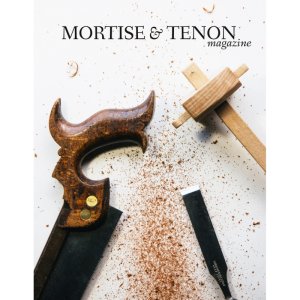
BOOK REVIEW:
Mortise & Tenon
Magazine, Edited by Joshua Klein
by J.Norman Reid
Delaplane, VA
My much-anticipated copy of
Mortise & Tenon Magazine
finally landed in my mailbox.
Frankly, I didn't know quite what to expect. From the advance information, I knew it
would include coverage of traditional furniture and cabinetmaking, but little more. Yet,
its promise to treat these subjects beautifully and informatively were enough to entice
me to subscribe.
When I opened M&T and handled its richly-illustrated pages, I was in no way
disappointed. The many photos—both color and black and white—drew me into its
stories and created an immediate desire to read it cover to cover, something I did in
very short order. What I discovered, when I did, was a magazine that plows ground not
currently cultivated by any other single publication on furniture or furniture-making.
Unlike traditional woodworking magazines, Mortise & Tenon is not devoted to the
design, tools or construction of furniture, though it does touch on those subjects. Nor is
it a set of treatises on the history of furniture styles. Rather, it's an explicit effort to
bring together into active communication the somewhat separated disciplines of period
furniture-making, furniture restoration, conservation, curating and scholarship. In doing
so, it recognizes the interdependencies of these related fields and the value of sharing
their contributions more freely across their combined areas of specialization. The
editor, Joshua Klein, himself a restorer of traditional furniture, sets out to achieve this
through a series of articles and interviews that probe ways these fields complement
each other.
The lead article sets out seven guiding principles for M&T, what Klein calls his
"manifesto." M&T will extend to furniture in both high and vernacular styles, focus on
pre-industrial era furniture, emphasize hands-on research, honor original construction
methods, respect the cultural heritage of extant furniture pieces, serve as a bridge
among makers, conservators and scholars of furniture, and celebrate historical furniture.
What then follow are a dozen articles and interviews that address a fascinating set of
subjects representing the promised mix of viewpoints. First are interviews with Jon
Brandon, a furniture conservator and founder of East Point Conservation in Brunswick,
Maine, and Phil Lowe, period furniture-maker and teacher in Beverly, Massachusetts.
They are succeeded by a pictorial analysis of a Federal Boston secretary that displays its construction and joinery in an extended series of close-up photographs, allowing the
reader to examine its details both inside and out.
Klein then presents the only construction article in the issue, the reproduction of an
ovolo top, grain-painted card table made by 19th century Maine minister and
cabinetmaker Jonathan Fisher. The article illustrates pre-industrial work methods rather
than a specific plan, but offers enough detail for the reader to replicate the table or a
similar model if desired.
An interview follows with Gerald W.R. Ward, Senior Curator of American Decorative
Arts and Sculpture Emeritus of the Museum of Fine Arts, Boston. Ward offers a glimpse
into his rule as a curator, which, as distinct from a conservator's role, is to collect,
preserve and interpret the items in a museum's collection.
An article on the origins of classical proportions by George Walker is next. Walker
points to an archeological site in southwest Turkey dating to about 9000 B.C. and
argues that it was constructed by a simple "artisan geometry" long before the methods
could be expressed in words. He points to the relevance of this simple geometry for
today's workshop as a means to express ratios and shapes using simple tools.
Walker's article is succeeded by Al Breed's lesson on carving a feathered eagle's tail as
often featured in Salem, Massachusetts, Federal furniture. Then, Klein reports on his
interview with Charles Hummel, Curator Emeritus at the Winterthur Museum, on new
discoveries about the Dominy Shop since Hummel's 1968 book on the workshop was
published.
Freddy Roman discusses the path that took him to his present role as a professional
furniture-maker and restorer and the skills and practices that enable him to survive in
this chosen field. Martin O'Brien, a North Carolina furniture restorer and craftsman,
explains the clues that help uncover the provenance and dating of period furniture
examples. These include irregularity, joinery, fasteners and hardware, tool marks,
surface coatings and other elements.
An interview with Eric Litke of the Furniture Study at the Yale University Art Gallery
follows. The Gallery holds numerous examples of period furniture objects of all types
that are available for examination by furniture-makers and researchers. A review of
Christopher Schwarz's 2015 book
Workbenches
and a sponsor directory conclude the
volume.
This rich collection of material, presented without advertising, touches a space little
covered in more traditional woodworking literature. I found it refreshing to explore
perspectives with which I was largely unfamiliar. The magazine's presentation is
beautiful, making it a feast for the eyes as well as for the mind.
M&T is intended to be published annually. Perhaps, in addition to this issue's
concentration on furniture and institutions from Klein's own New England, the next issue
will venture into the high styles and vernacular furniture and museums representing the
mid-Atlantic and southern states as well. In the meantime, I for one will eagerly await its
publication.
CLICK HERE to order your copy of
Mortise & Tenon
The author is a woodworker, writer, and woodworking instructor living in the Blue Ridge Mountains with his wife, a woodshop full of power and hand tools and four cats who think they are cabinetmaker's assistants. He is the author of the forthcoming book
Choosing and Using Handplanes.
He can be reached by email at
nreid@fcc.net.
Return to Main page
